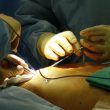Almost 30% of all patients experience some degree of myocardial injury after elective angioplasty, a statistic associated to an increase in cardiovascular events at 30 days and 1 year, according to this study recently published in Eur Heart J. The study only included consecutive patients who underwent elective angioplasty with a negative troponin level at admission. The...
Peri-Procedural Infarction: More Frequent than and Not as Innocent as We Thought
Almost 30% of all patients experience some degree of myocardial injury after elective angioplasty, a statistic associated to an increase in cardiovascular events at 30 days and 1 year, according to this study recently published in Eur Heart J. The study only included consecutive patients who underwent elective angioplasty with a negative troponin level at admission. The...
Additional Benefit from Radial Artery Graft in Myocardial Revascularization Surgery
Used to different extents according to institution, surgeon, and historical time, the radial artery graft is yet to prove whether it can improve the outcomes of myocardial revascularization surgery when added to a single or bilateral internal thoracic artery graft. The ART (Arterial Revascularization Trial) was designed to compare survival after bilateral vs. single left internal...
DETO2X-AMI: Supplemental O2 Provides No Benefit for Patients with Suspected Infarction
According to this study simultaneously presented at the European Society of Cardiology Congress 2017 and published in the New England Journal of Medicine, routinely providing supplemental oxygen therapy to patients without hypoxemia with suspected acute myocardial infarction did not result in a reduction in the 1-year risk of all-cause mortality when compared with patients receiving...
Follow-up at 10 years for invasive vs. conservative strategy for non-ST-segment elevation infarction
The ICTUS (Invasive Versus Conservative Treatment in Unstable Coronary Syndromes) trial compared early invasive strategy with a selective invasive strategy in patients with non-ST-segment elevation acute coronary syndrome (NSTE-ACS), with elevated markers such as cardiac troponin T. The absence of long-term benefit of an early invasive strategy at 1 and 5 years had already been reported....
Myocardial Revascularization Surgery: One or Two Internal-Thoracic-Artery Grafts?
The use of both internal thoracic (mammary) arteries for myocardial revascularization surgery might improve long-term outcomes, compared with the use of a single internal thoracic artery. Patients scheduled for myocardial revascularization surgery (only multivessel procedures; combined valve procedures were excluded) were randomized to receive a single internal-thoracic-artery graft (internal thoracic artery for the anterior...
Metoprolol before primary PCI doesn’t reduce infarction size
Original Title: Early Intravenous Beta-Blockers in Patients with ST-Segment Elevation Myocardial Infarction before Primary Percutaneous Coronary Intervention. Reference: Roolvink V et al. J Am Coll Cardiol. 2016 Jun 14;67(23):2705-15. The impact of endovenous beta-blockers before primary PCI has not been established yet. This is the first double blind multicenter trial, controlled with placebo, to...
Morphine Increases Platelet Reactivity in Infarctions
The use of morphine in patients undergoing ST elevation acute coronary syndromes is associated to higher platelet reactivity and lower thrombolysiscapacity, according to this small study. The negative effects seem to resolve 2 days after administration. This transient effect is believed to be the result of the inhibition of the normal muscular activity of the...
POST trial: Post-conditioning effect in myocardial reperfusion with primary angioplasty.
Ischemic postconditioning obtained through reversible ischemia and reproduced during reperfusion after a prolonged ischemic injury has shown comparable effects to ischemic preconditioning in preclinical phase. A study in humans showed a reduction in serum markers of AMI thanks to Ischemic postconditioning in the context of primary angioplasty. Different MRI studies showed conflicting results regarding the...
TIME: Use and duration of bone marrow derived stem cells infusion for the treatment of post infarction ventricular dysfunction.
This study randomized 120 patients with acute myocardial infarction after successful primary angioplasty with a residual ejection fraction (LVEF) <45%. An intracoronary infusion with fixed doses of bone marrow derived stem cells vs. placebo was administered (randomization 2:1) 3 days after infarction vs. 7 (randomization 1:1). The objective was to assess ventricular and contractile function...








